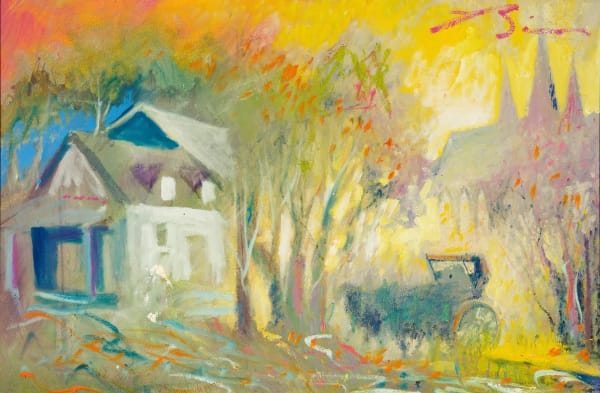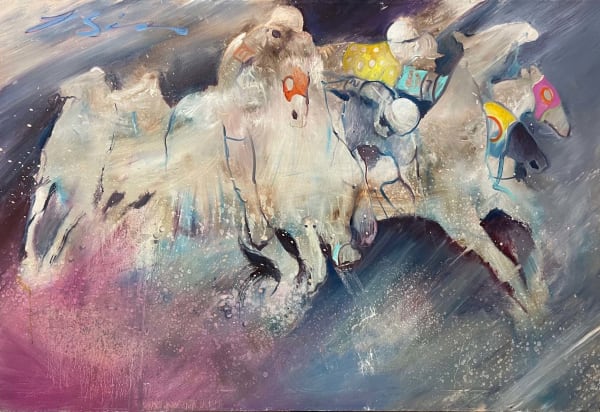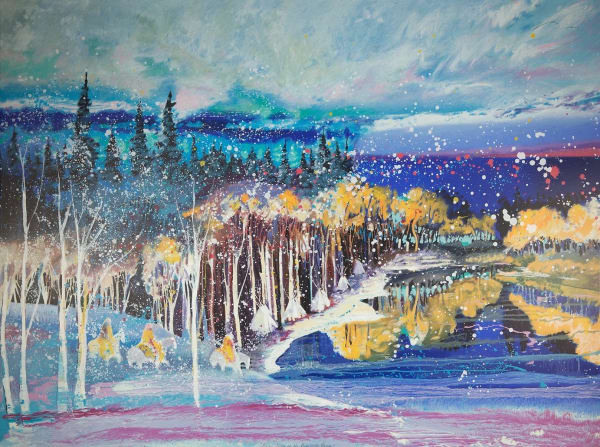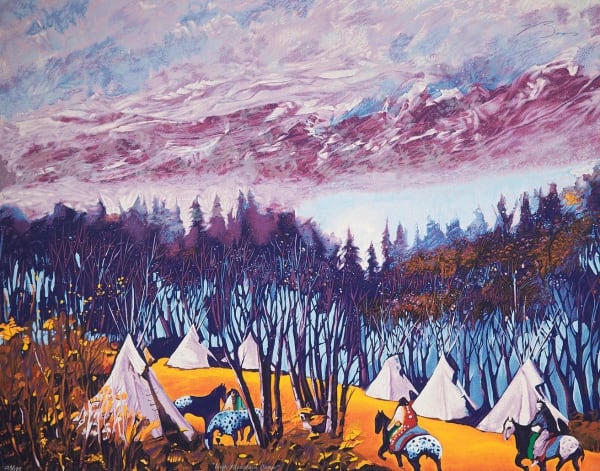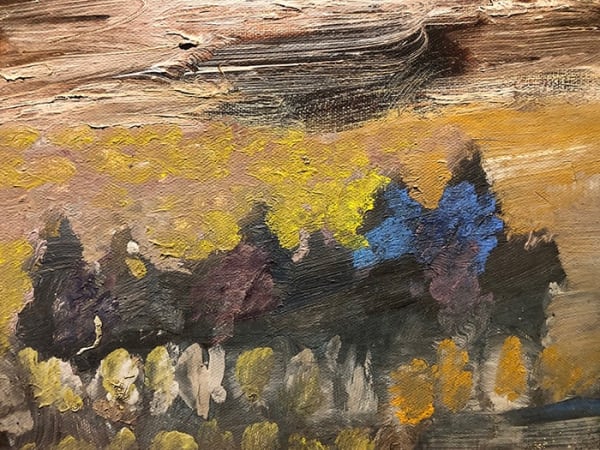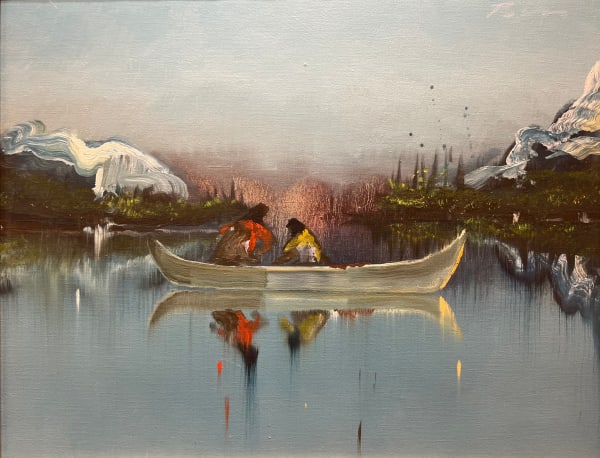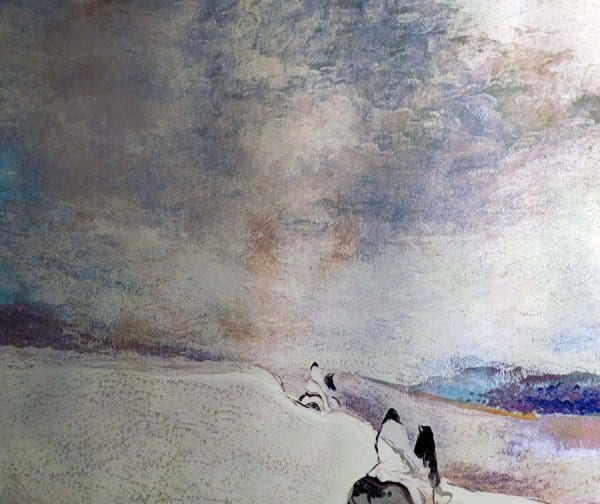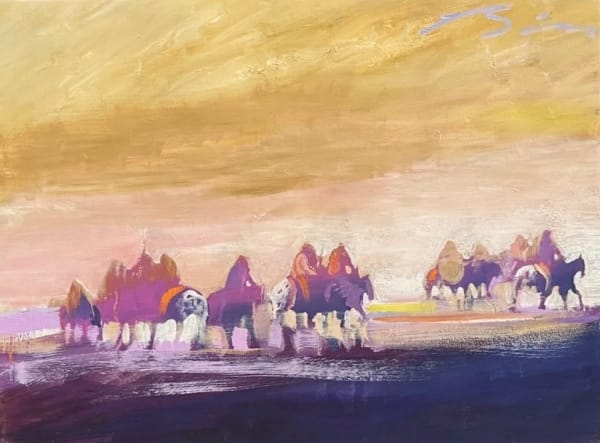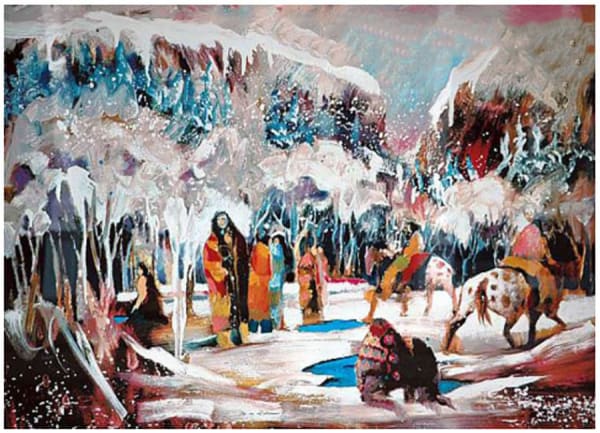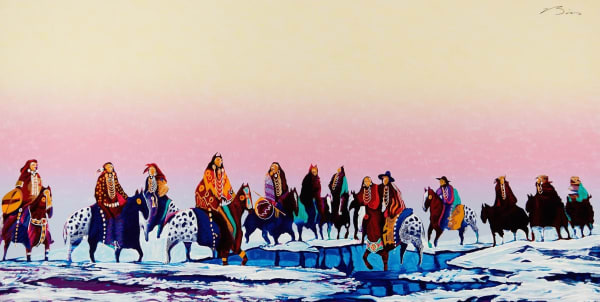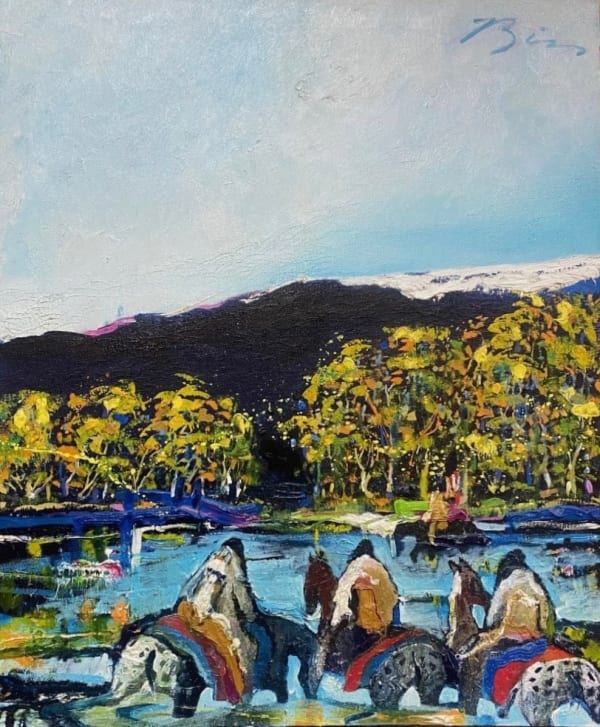Earl Biss
-
 Carriage on a Stormy Afternoon , 1994
Carriage on a Stormy Afternoon , 1994 -
 Apsaalooke March, 1981
Apsaalooke March, 1981 -
 A Bright Afternoon in France
A Bright Afternoon in France -
 A Portrait of My Great Uncle Curly The Scout
A Portrait of My Great Uncle Curly The Scout -
 A Vision Sketch in Pleasant Oil
A Vision Sketch in Pleasant Oil -
 Aiken Afternoon
Aiken Afternoon -
 Another Storm Along the Rockies
Another Storm Along the Rockies -
 Autumn Mountain Haze
Autumn Mountain Haze -
 Autumn Storm on Crazy Woman Mountains
Autumn Storm on Crazy Woman Mountains -
 Beartooth Range
Beartooth Range -
 Beartooth Range
Beartooth Range -
 Blizzard Along the Beartooth Range
Blizzard Along the Beartooth Range -
 Bringing Children Home from Star School (State II)
Bringing Children Home from Star School (State II) -
 Buggy Riders on a Snowy Day
Buggy Riders on a Snowy Day -
 Camp at the Gap Near Arrow Creek
Camp at the Gap Near Arrow Creek -
 Camp of the Mountain Crows
Camp of the Mountain Crows -
 Changing Leads at a Full Gallop
Changing Leads at a Full Gallop -
 Cotton Woods in Green & Orange
Cotton Woods in Green & Orange -
 Crazy Dogs in the Sun
Crazy Dogs in the Sun -
 Early Snow in the Beartooth Range
Early Snow in the Beartooth Range -
 End of the Trail
End of the Trail -
 Fire Of The Autumn Leaves
Fire Of The Autumn Leaves -
 High Mountain Camp
High Mountain Camp -
 High Mountain Campground
High Mountain Campground -
 Horse Thieves at Dawn
Horse Thieves at Dawn -
 Indian with Light Bulb
Indian with Light Bulb -
 Jeering the Dog Eaters
Jeering the Dog Eaters -
 Land of the Free Home of the Brave
Land of the Free Home of the Brave -
 Landscape in Green
Landscape in Green -
 Late Winter Pass
Late Winter Pass -
 Mist Between Day and Night
Mist Between Day and Night -
 Morning Camp
Morning Camp -
 Mountain Crows
Mountain Crows -
 Mountain Glory Boys in Blue
Mountain Glory Boys in Blue -
 Passing Windy Point
Passing Windy Point -
 Poncho in his Sunday Best
Poncho in his Sunday Best -
 Rainbow Warriors Wandering Through the Autumn
Rainbow Warriors Wandering Through the Autumn -
 Red Lodge
Red Lodge -
 Reflections on Still Waters
Reflections on Still Waters -
 Return of the Raven to the Skokomish
Return of the Raven to the Skokomish -
 Rhythm of the Restless
Rhythm of the Restless -
 Riders In An Autumn Wind
Riders In An Autumn Wind -
 Salmon Fishing on Columbia River
Salmon Fishing on Columbia River -
 Silent Sunrise Morning
Silent Sunrise Morning -
 Sitting Indians
Sitting Indians -
 Sixteen Crows in Grey
Sixteen Crows in Grey -
 Spring of the Rainbow Warriors
Spring of the Rainbow Warriors -
 Standing in a Chinook Wind
Standing in a Chinook Wind -
 Storm on Thunder Mountain
Storm on Thunder Mountain -
 Strolling Through a Fire in the Sky 1991
Strolling Through a Fire in the Sky 1991 -
 Strolling Through a Poplar Grove at the Base of Black Canyon
Strolling Through a Poplar Grove at the Base of Black Canyon -
 Sunrise Morning in Purple and Orange 1987
Sunrise Morning in Purple and Orange 1987 -
 Sunrise on the Whistling Waters
Sunrise on the Whistling Waters -
 The Green Grass of Home
The Green Grass of Home -
 The Ice Fisherman
The Ice Fisherman -
 The Journey to Find the Rainbow Medicine's Home
The Journey to Find the Rainbow Medicine's Home -
 The Slip
The Slip -
 They Stood Like the Glory of the Sun
They Stood Like the Glory of the Sun -
 Turn of the Century Indians with New Hats and Old Hats (State II)
Turn of the Century Indians with New Hats and Old Hats (State II) -
 Unfinished Painting of an Untold Story
Unfinished Painting of an Untold Story -
 Untitled
Untitled -
 Untitled
Untitled -
 Untitled
Untitled -
 Untitled
Untitled -
 Untitled Aspen Trees & The Rockies
Untitled Aspen Trees & The Rockies -
 Viston of Fog In A Morning
Viston of Fog In A Morning -
 Walking the Yellowstone
Walking the Yellowstone -
 Walking Upon the Thundering Waters
Walking Upon the Thundering Waters -
 War Flags on Broken Waters
War Flags on Broken Waters -
 War Shields Winter Vision
War Shields Winter Vision -
 Watching the Camp
Watching the Camp -
 Water Lilies with My Mind Deep in the Rainforest
Water Lilies with My Mind Deep in the Rainforest -
 Wind, River, Snow
Wind, River, Snow -
 Winter Wind Along The Rim Rocks
Winter Wind Along The Rim Rocks -
 Yellow Robes in the Crazy Woman Mountains
Yellow Robes in the Crazy Woman Mountains
Biss was a central figure in the "miracle generation" of students at the Institute of American Indian Arts (IAIA) in Santa Fe in the 1960s. When Earl and his fellow students – which included Kevin Red Star, T.C. Cannon and Doug Hyde – arrived at IAIA, western art was focused on cowboys and landscapes, while Native art was stylized, linear and depictive. That perspective was too narrow for Biss, who studied painting with Fritz
Scholder, sculpture with Allan Houser, jewelry and design with Charles Loloma, and architecture with Paolo Soleri. Inspired by these teachers, as well as fauvism, impressionism, expressionism, and other modernist
movements, Biss pushed himself and his friends to create an entirely new genre that we know today as Contemporary Southwestern Art. "Earl was the catalyst," Red Star said.
Biss went on to the San Francisco Art Institute on a full scholarship, then moved to Paris where he haunted museums and studied printmaking with S. W. Hayter. Returning to Santa Fe, he rented studio space with several of his fellow artists who continually challenged each other to further develop their unique styles.
Biss often painted in bursts of 48 to 72 hours or more, eating little and sometimes working to collapse. He created thousands of paintings and drawings in his lifetime, many of which sold so fast their whereabouts are unknown. He remained at the top of his field for thirty years. Even as his career skyrocketed, Earl admittedly struggled with alcohol and other substances, and went through multiple relationships and marriages. While attempting to balance Native ways in a white man's world, his love for art superseded any of life's challenges. His mastery with oils evolved over time with colors becoming richer and with unparalleled depth as he pushed
the edge of what is possible in wet-in-wet technique. Expressionist - yet always giving enough imagery to ground the viewer - Earl Biss was ever the explorer. He continued to stretch of the boundaries of the genre of Contemporary Southwest Art up until his last day on this Earth.
Weakened both by his lifestyle and a childhood bout with rheumatic fever that damaged his heart, Earl Biss died of a stroke in his Santa Fe studio in 1998. His works in the Contemporary Southwestern Art style are now collected worldwide.


